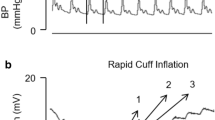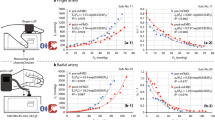Summary
Transcutaneous ultrasonography is a noninvasive technique with the ability to measure the volumetric blood flow of the peripheral circulation. Peripheral blood flow can be determined by highresolution imaging of vessel diameter coupled with Doppler assessment of flow velocity. This method, however, has not been validated in vivo. Accordingly, brachial artery flow in response to intraarterial infusion of vasodilators was assessed by ultrasonography in 16 healthy subjects and compared to values obtained simultaneously by venous occlusion plethysmography. Blood flow calculated from ultrasound-derived vessel diameter and flow velocity was found to highly correlate with plethysmographic flow, withr values ranging from 0.83 to 0.99. Using this ultrasound technique combined with plethysmography, the response of conduit and resistance vessels to endothelium-mediated vasodilation was characterized. Doppler velocity rose dramatically with endothelium-dependent acetylcholine (970%), but only modestly with endothelium-independent vasodilators, nitroglycerin (292%) and nitroprusside (340%). Despite eliciting the greatest overall forearm flow response, acetylcholine resulted in a smaller increase in conduit diameter (15.4%) than nitroglycerin (21.8%), and only a comparable change than nitroprusside (14.6%). Taken together, these results suggest that acetylcholine acts predominantly on resistance vessels, whereas nitrovasodilators affect mainly conduit vessels. In summary, transcutaneous ultrasonography can be used reliably to assess flow changes in the peripheral circulation. Combined with plethysmography, this technique is useful for determining the relative contribution of conduit and resistance vessels to peripheral flow, particularly in the assessment of endothelium-mediated vasodilation.
Similar content being viewed by others
References
Lewis P, Psaila JV, Davies WT, McCarthy K, Woodcock JP (1996) Measurement of volume flow in the human common femoral artery using a duplex ultrasound system. Ultrasound Med Biol 12:777–784
Whitney RJ (1953) The measurement of volume changes in human limbs. J Physiol 121:1–27
Vogel RA (1993) Endothelium-dependent vasoregulation of coronary artery diameter and blood flow. Circulation 88:325–327
Pohl U, Hultz J, Busse R, Basenge E (1986) Crucial role of endothelium in the vasodilator response to increased flow in vivo. Hypertension 8:37–44
Zeiher AM, Drexler H, Wollschlager H, Meinertz T, Just H, Bonzel T (1989) Flow-dependent coronary dilatation in humans. Circulation 80:466–474
Rubanyi GM, Romero C, Vanhoutte PM (1986) Flowinduced release of endothelium-derived relaxing factor. Am J Physiol 250:1115–1119
Joannides R, Haefeli WE, Linder L, Richard V, Bakkali EH, Thuillex C, Luscher TF (1995) Nitric oxide is responsible for flow-dependent dilatation of human peripheral conduit arteries in vivo. Circulation 90:1314–1319
Houghton JL, Davison CA, Kuhner PA, Torossov MT, Strogatz DS, Carr AA (1998) Heterogeneous vasomotor responses of coronary conduit and resistance vessels in hypertension. J Am Coll Cardiol 31:374–382
Zeiher AM, Drexler H, Saurbier B, Just H (1993) Endothelium-mediated coronary blood flow modulation in humans: effects of age, atherosclerosis, hypercholesterolemia, and hypertension. J Clin Invest 92:652–662
Ludmer PL, Selwyn AP, Shook TL, Wayne RR, Mudge GH, Alexander RW, Ganz P (1986) Paradoxical vasoconstriction induced by acetylcholine in atherosclerotic coronary arteries. N Engl J Med 315:1046–10451
Zeiher AM, Drexler H, Wollschlager H, Hanjorg J (1991) Modulation of coronary vasomotor tone in humans. Circulation 83:391–401
Greenfield ADM, Whitney RJ, Mowbray JF (1963) Methods for the investigation of peripheral blood flow. Br Med Bull 19:101–109
Fam WM, McGregor M (1968) Effect of nitroglycerin and dipyridamole on regional coronary resistance. Circ Res 22:649–659
Simonetti I, Rossen JD, Winniford MD, Marcus ML (1989) Biphasic effect of nitorglycerin or coronary hemodynamics in normal subjects. Z Kardiol 78:52–55
Winbury MM, Howe BB, Hefner MA (1969) Effect of nitrates and other coronary dilators on large and small coronary vessels: an hypothesis for the mechanism of action of nitrates. J Pharamcol Exp Ther 168:70–95
Kurz MA, Lamping KG, Bates JN, Eastham CL, Marcus ML, Harrison DG (1991) Mechanisms responsible for the heterogeneous coronary microvascular response to nitroglycerin. Circ Res 68:847–855
Sellke FW, Tomanek RJ, Harrsion DG (1991)l-Cysteine selectively potentiates nitroglycerin-induced dilation of small coronary microvessels. J Pharmacol Exp Ther 258:365–369
Creager MA, Cooke JP, Mendelsohn ME, Gallagher SJ, Coleman SM, Loscalzo J, Dzau VJ (1990) Impaired vasodilation of forearm resistance vessels in hypercholesterolemic humans. J Clin Invest 86:228–234
Chowienczyk PJ, Watts GF, Cockcroft JR, Ritter JM (1992) Impaired endothelium-dependent vasodilation of forearm resistance vessels in hypercholesterolemia. Lancet 340:1430–1432
Calver A, Collier J, Vallance P (1992) Inhibition and stimulation of nitric oxide synthesis in the human forearm arterial bed of patients with insulin-dependent diabetes. J Clin Invest. 90:2548–2554
Johnstone MT, Creager SJ, Scales KM, Cusco JA, Lee BK, Creager MA (1993) Impaired endotheliumdependent vasodilation in patients with insulin-dependent diabetes mellitus. Circulation 88:2510–2516
Katz SD, Biasucci L, Sabba C, Strom JA, Jondeau G, Galvao M, Solomon S, Nikolic SD, Forman R, LeJemtel TH (1992) Impaired endothelium-mediated vasodilation in the peripheral vasculature of patients with congestive heart failure. J Am Coll Cardiol 19:918–925
Bank AJ, Rector TS, Tschumperlin LK, Kraemer MD, Letourneau JC, Kubo SH (1994) Endothelium-dependent vasodilation of peripheral conduit arteries in patients with heart failure. J Cardiac Failure 1:35–43
Pallares LCM, Deane CR, Baudouin SV, Evans TW (1994) Strain gauge plethysmography and Doppler ultrasound in the measurement of limb blood flow. Eur J Clin Invest 24:279–286
Longhurst J, Capone RJ, Mason DT, Selis R (1974) Comparison of blood flow measured by plethysmograph and flowmeter during steady state forearm exercise. Circulation 49:535–540
Raman ER, Vanhuyse VJ, Jageneau AH (1973) Comparison of plethysmographic and electromagnetic flow measurements. Phys Med Biol 18:704–711
Author information
Authors and Affiliations
Rights and permissions
About this article
Cite this article
Wu, H.D., Katz, S.D., Beniaminovitz, A. et al. Assessment of endothelium-mediated vasodilation of the peripheral circulation by transcutaneous ultrasonography and venous occlusion plethysmography. Heart Vessels 14, 143–148 (1999). https://doi.org/10.1007/BF02482298
Received:
Revised:
Accepted:
Issue Date:
DOI: https://doi.org/10.1007/BF02482298




